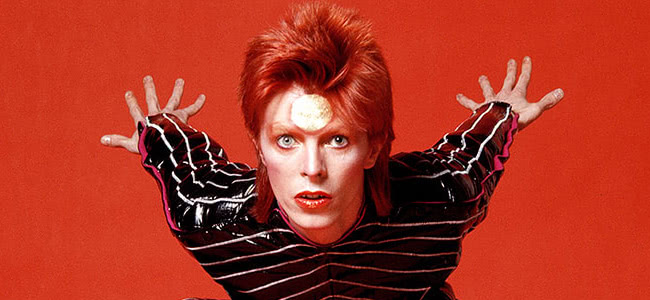Now in light of his untimely passing, more than ever it’s important to remember that there isn’t nor will there ever be anyone quite like the musical chameleon that is David Bowie.
The 69 year old’s legacy and influential sphere is as wide as The Beatles, Bob Dylan or The Velvet Underground, however Bowie’s arsenal of sound extends far beyond either any of these three important acts, having continually pushed his own creative boundaries into a myriad of genres expanding from traditional folk, dolled-up glam rock, groovin’ funk and soul with hints of jazz, he’s pushed the buttons of electronica, traded lyrics for haunting ambience, powered through ’80s synth and dance, not to mention his experimentation with industrial and alt-rock, there’s very few sonic rocks in the Bowie court that remain unturned.
Despite still releasing brilliant and interesting new music in both 2013 and 2014, and just a handful of days ago in the form of Blackstar, Bowie no longer hits the open road for tours however that doesn’t mean there isn’t opportunity to celebrate the legend’s artistry in live performance.
Space Oddity (1969)
For so, so many, this was the first image anyone ever saw of David Bowie, and despite the amount of changes the man went through, it’s definitely been ever-lasting, who could ever forget the alien-like figure with the insane red mullet straddling an acoustic guitar on the ‘Space Oddity’ music video?
In saying that, this record is so much more than just the iconic introduction to “Major Tom”, the album laden with folk-pop tunes like ‘Unwashed and Somewhat Slightly Dazed’ to the twang-meets-psychedelica, ‘Memory Of A Free Festival’ that closes the record out in the ultimate euphoric chorusing – something that would surely be found later in Bowie’s work.
The Rise and Fall Of Ziggy Stardust and the Spiders From Mars (1972)
No matter what phase of David Bowie you were introduced to, all sounds lead listeners a time when the alien-like character Ziggy Stardust walked planet earth playing glam rock tunes.
Love The Beatles?
Get the latest The Beatles news, features, updates and giveaways straight to your inbox Learn more
Critically acclaimed, Bowie’s undeniable magnum opus saw both he and his incredibly talented guitarist Mick Ronson at their collaborative finest, producing an 11-track piece of output that would be the blueprint of a musical genre and was the soundtrack of a cultural movement: glam rock.
Of course, everyone knows the more famous tracks like ‘Ziggy Stardust’, ‘Moonage Daydream’ and ‘Starman’ however, the record boasts of infinite Bowie brilliance. Hearts still skip with the drumbeat of album introducer ‘Five Years’, fans still belt the chorus of ‘Lady Stardust’ and the fashion world are still using the title ‘Rock ‘n’ Roll Suicide’ as a name for countless shows and clothing lines.
The Rise and Fall of Ziggy Stardust and the Spiders From Mars is as musically and culturally important as Sergeant Peppers or Exile On Main Street.
Diamond Dogs (1974)
The concept for Bowie’s last dance in glam rock was inspired by the George Orwell novel Nineteen Eighty-Four, however he was unable to gain full rights from the author’s estate and as such, had to tweak the record toward a more Bowie post-apocalyptic world.
It’s pretty hard to ignore the stand-out song from this album, Bowie’s most accessible pop-hit with the cracking instant-classic riff, ‘Rebel Rebel’.
Young Americans (1975)
The second record of focus for the Bowie Tribute night is Bowie’s mid ’70s genre switcheroo, seamlessly gliding from the the arty, glam rock of Diamond Dogs to the funk and soul of Philadelphia on Young Americans.
The album, outside of being one of Bowie’s greatest, marks one of many major turning points in his creative endeavours that continued into the following year with the equally revered Station To Station.
Young Americans was championed by the the title track single, as well as the groovin’ jam ‘Fame’, a track penned alongside the likes of John Lennon and Carlos Alomar.
Despite fears the album wouldn’t be received well in the US in particular as Bowie was a white dude from the UK taking on a musical culture so distant from his own (the album’s sound even described as “plastic soul”), Young Americans flourished, charting in the top 10.
Low (1977)
A new year marked many fresh things for David Bowie, a new haircut, a new style, a (re)newed friendship with Iggy Pop and a new home in Berlin, which all came together for one very new sound.
Although the crown jewel of Bowie’s creative output will forever be point of contention, the strongest of consensus lies with Low, David Bowie’s foray into the world of experimental electronics and ambience.
Co-produced by Tony Visconti with contributions from the mastermind that is Brian Eno, the record is yet another turning point in Bowie’s life as he attempts to kick his horrid cocaine addiction, the album oozing with Bowie’s pain both lyrically and sonically, the album a dark, twisted beginning to what is known as the Berlin Trilogy.
Let’s Dance (1983)
Ditching Berlin as his experiments with electronica and ambience, Bowie recorded his incredibly accessible pop album Let’s Dance in New York City alongside the one and only Nile Rogers, the super producer’s disco and funk touch taking Bowie to yet another realm of brilliance.
Charged by the throbbing title track – with a video that was actually filmed in Australia – the record is laden with classic ’80s disco-pop songs that have stood the test of time as jukebox and drunken party favourites.
From the sparkling ‘Modern Love’ to the rmieagination of Iggy Pop’s ‘China Girl’, not to mention a reissue in 1995 to include the ultimate duet ‘Under Pressure’ with Queen, Let’s Dance is yet another shade of Bowie perfection.
The Next Day (2013)
David Bowie has always been cited as an artist one step ahead of others, and when he shocked the world with the release of the more alt-rockin’ industrial The Next Day, his 24th studio LP mind you, he once again cemented this notion and influenced a whole new method of releasing albums – let’s not forget when the world broke-down after Beyoncé dropped her self-titled record at the end of 2013.
Like the vast majority of his music, this record too sold like hotcakes as Bowie showed the world he can still pen killer, original music.
NOTE: This piece was originally published on 19/3/15 but has been updated on 12/1/16 in light of Bowie’s death.




































